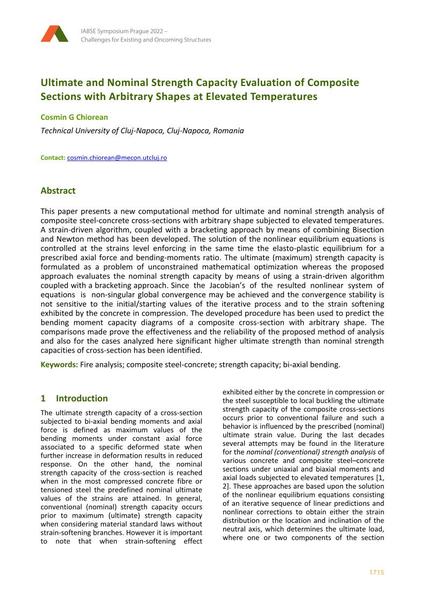Ultimate and Nominal Strength Capacity Evaluation of Composite Sections with Arbitrary Shapes at Elevated Temperatures

|
|
|||||||||||
Détails bibliographiques
| Auteur(s): |
Cosmin G. Chiorean
(Technical University of Cluj-Napoca, Cluj-Napoca, Romania)
|
||||
|---|---|---|---|---|---|
| Médium: | papier de conférence | ||||
| Langue(s): | anglais | ||||
| Conférence: | IABSE Symposium: Challenges for Existing and Oncoming Structures, Prague, Czech Republic, 25-27 May 2022 | ||||
| Publié dans: | IABSE Symposium Prague 2022 | ||||
|
|||||
| Page(s): | 1715-1722 | ||||
| Nombre total de pages (du PDF): | 8 | ||||
| DOI: | 10.2749/prague.2022.1715 | ||||
| Abstrait: |
This paper presents a new computational method for ultimate and nominal strength analysis of composite steel-concrete cross-sections with arbitrary shape subjected to elevated temperatures. A strain-driven algorithm, coupled with a bracketing approach by means of combining Bisection and Newton method has been developed. The solution of the nonlinear equilibrium equations is controlled at the strains level enforcing in the same time the elasto-plastic equilibrium for a prescribed axial force and bending-moments ratio. The ultimate (maximum) strength capacity is formulated as a problem of unconstrained mathematical optimization whereas the proposed approach evaluates the nominal strength capacity by means of using a strain-driven algorithm coupled with a bracketing approach. Since the Jacobian’s of the resulted nonlinear system of equations is non-singular global convergence may be achieved and the convergence stability is not sensitive to the initial/starting values of the iterative process and to the strain softening exhibited by the concrete in compression. The developed procedure has been used to predict the bending moment capacity diagrams of a composite cross-section with arbitrary shape. The comparisons made prove the effectiveness and the reliability of the proposed method of analysis and also for the cases analyzed here significant higher ultimate strength than nominal strength capacities of cross-section has been identified. |
||||
| Copyright: | © 2022 International Association for Bridge and Structural Engineering (IABSE) | ||||
| License: | Cette oeuvre ne peut être utilisée sans la permission de l'auteur ou détenteur des droits. |
||||
